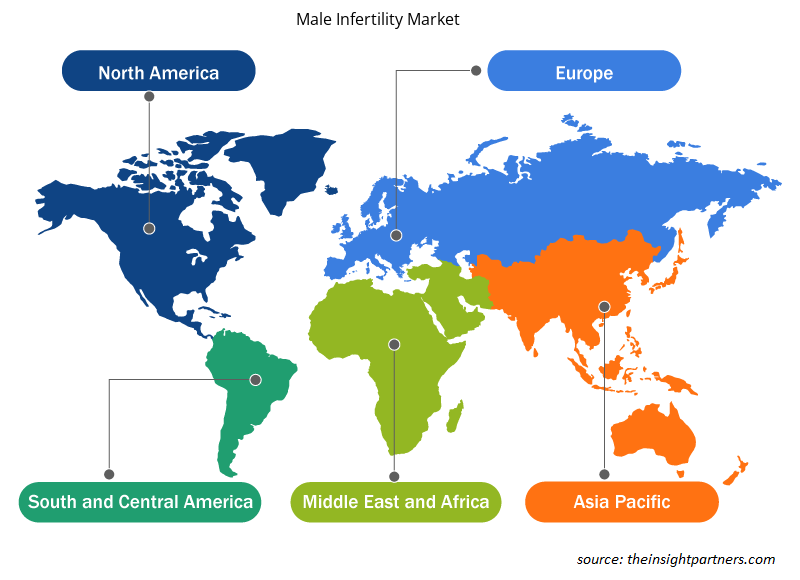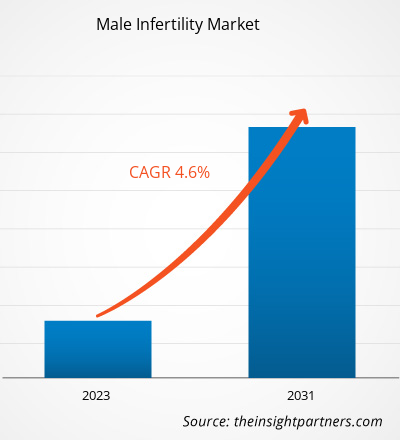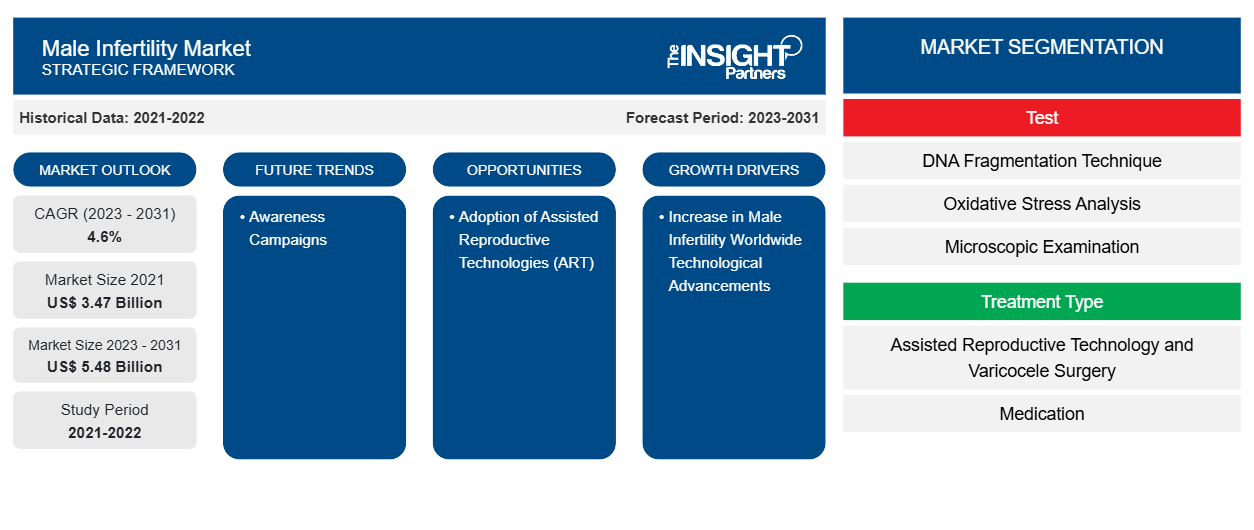2021 年男性不育市场规模为 34.7 亿美元,预计到 2031 年将从 2023 年的 XX 亿美元增至 54.8 亿美元。预计 2023-2031 年市场复合年增长率为 4.6%。采用辅助生殖技术 (ART) 可能仍是男性不育市场的主要趋势。
男性不育市场分析
男性不育市场的增长得益于不育率的上升、辅助生殖技术 (ART) 的广泛采用以及 ART 的技术进步等因素。此外,压力水平的增加、肥胖、吸烟和饮酒都是导致男性不育的因素。此外,意识的增强、研发支出的增加以及生活方式的改变都在推动男性不育市场的发展。
男性不育市场概况
男性不育是现代社会的一大问题。不育一直被认为是女性的问题。然而,男性占所有不育病例的近一半。男性不育最常见的原因是精子数量减少、睾丸激素水平下降以及勃起功能障碍和睾丸癌发病率上升等问题。此外,污染还会影响男性的生育能力,尤其是精子质量。
定制此报告以满足您的需求
您可以免费定制任何报告,包括本报告的部分内容、国家级分析、Excel 数据包,以及为初创企业和大学提供优惠和折扣
-
获取此报告的关键市场趋势。这个免费样品将包括数据分析,从市场趋势到估计和预测。
男性不育市场驱动因素和机遇
全球男性不育率上升利好市场增长
男性不育症是指男性无法使有生育能力的女性怀孕。不育症通常是由于精液缺乏和精液质量等因素造成的。男性不育症是一个全球普遍存在的问题,各个地区的比例各不相同。根据美国国立卫生研究院 (NIH) 于 2023 年发表的一篇文章,男性不育症影响了全球 7% 的男性人口。此外,非洲和东欧的男性不育率最高。
宣传活动
国际生殖健康教育合作组织 (IRHEC) 前身为国际生育教育倡议,成立于 2021 年。其宗旨是通过教育提高生育意识。有效促进生育健康素养或意识的教育材料对于做出明智的生殖决策、预防和管理生育能力低下和不孕症至关重要。
男性不育市场报告细分分析
有助于得出男性不育市场分析的关键部分是测试、治疗类型、分销渠道和最终用户。
- 根据测试,男性不育市场分为 DNA 碎片技术、氧化应激分析、显微镜检查、精子凝集、计算机辅助精液分析、精子渗透试验等。DNA 碎片技术部分在 2023 年占据了更大的市场份额。
- 根据治疗类型,市场分为辅助生殖技术和精索静脉曲张手术以及药物治疗。辅助生殖技术和精索静脉曲张手术领域在 2023 年占据了最大的市场份额。
- 根据分销渠道,市场分为医院药房、药店和药店、网上药店。医院药房部分在 2023 年占据了最大的市场份额。
- 就终端用户而言,市场分为医院和诊所、生育中心、研究机构和其他终端用户。2023 年,生育中心市场占据主导地位。
男性不育市场份额(按地区)分析
男性不育市场报告的地理范围主要分为五个地区:北美洲、亚太地区、欧洲、中东和非洲、南美洲和中美洲。
北美主导着男性不育市场。酒精和药物消费的增加、压力水平的上升、肥胖、吸烟和环境毒素是预计将加速北美男性不育市场增长的几个因素。此外,在研究期间,人们对该疾病的认识提高和紧张情绪的减少预计将推动对男性不育治疗的需求。
男性不育市场区域洞察
Insight Partners 的分析师已详尽解释了预测期内影响男性不育市场的区域趋势和因素。本节还讨论了北美、欧洲、亚太地区、中东和非洲以及南美和中美洲的男性不育市场细分和地理位置。

- 获取男性不育市场的区域具体数据
男性不育市场报告范围
| 报告属性 | 细节 |
|---|---|
| 2021 年市场规模 | 34.7 亿美元 |
| 2031 年市场规模 | 54.8亿美元 |
| 全球复合年增长率(2023 - 2031) | 4.6% |
| 史料 | 2021-2022 |
| 预测期 | 2023-2031 |
| 涵盖的领域 |
通过测试
|
| 覆盖地区和国家 |
北美
|
| 市场领导者和主要公司简介 |
|
男性不育市场参与者密度:了解其对业务动态的影响
男性不育市场正在快速增长,这得益于终端用户需求的不断增长,而这些需求又源于消费者偏好的不断变化、技术进步以及对产品优势的认识不断提高等因素。随着需求的增加,企业正在扩大其产品范围,进行创新以满足消费者的需求,并利用新兴趋势,从而进一步推动市场增长。
市场参与者密度是指在特定市场或行业内运营的企业或公司的分布情况。它表明在给定市场空间中,相对于其规模或总市场价值,有多少竞争对手(市场参与者)存在。
在男性不育市场运营的主要公司有:
- 默克集团,
- 赛诺菲,
- 拜耳公司,
- Endo Pharmaceuticals Inc.,
- SCSA Diagnostics, Inc.
- 男科学解决方案,
免责声明:上面列出的公司没有按照任何特定顺序排列。

- 了解男性不育市场顶级关键参与者概况
男性不育市场新闻和最新发展
男性不育市场通过收集一手和二手研究后的定性和定量数据进行评估,其中包括重要的公司出版物、协会数据和数据库。以下是男性不育市场的发展情况:
- Sidra Medicine 开设了一家新的男性不育诊所,作为其在卡塔尔拓展私人生殖医学服务的一部分。(来源:Sidra Medicine,新闻编辑室,2022 年)
- 领先的科技公司默克公司今天宣布,欧盟委员会 (EC) 已授予其新款 GONAL-f(促卵泡激素 alfa)150 IU 注射笔的营销授权 (MA)。这意味着默克公司现在提供更全面的一流注射笔系列,为需要较低剂量的患者从生育刺激周期开始到结束提供支持。(来源:默克集团,新闻稿,2020 年)
男性不育市场报告覆盖范围和交付成果
“男性不育市场规模和预测(2021-2031)”报告对以下领域进行了详细的市场分析:
- 范围内所有主要细分市场的全球、区域和国家层面的市场规模和预测
- 市场动态,如驱动因素、限制因素和关键机遇
- 未来主要趋势
- 详细的 PEST/波特五力分析和 SWOT 分析
- 全球和区域市场分析涵盖关键市场趋势、主要参与者、法规和最新市场发展
- 行业格局和竞争分析,涵盖市场集中度、热点图分析、知名参与者和最新发展
- 详细的公司简介
- 历史分析(2 年)、基准年、预测(7 年)及复合年增长率
- PEST和SWOT分析
- 市场规模、价值/数量 - 全球、区域、国家
- 行业和竞争格局
- Excel 数据集
近期报告
客户评价
购买理由
- 明智的决策
- 了解市场动态
- 竞争分析
- 客户洞察
- 市场预测
- 风险规避
- 战略规划
- 投资论证
- 识别新兴市场
- 优化营销策略
- 提升运营效率
- 顺应监管趋势























 获取免费样品 - 男性不育市场
获取免费样品 - 男性不育市场